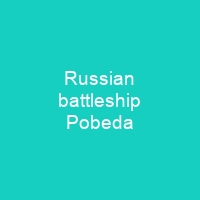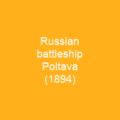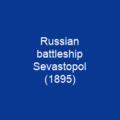Pobeda: The Last of the Peresvet-Class Battleships
Imagine a time when battleships were the ultimate symbol of naval power, and the Imperial Russian Navy was at its zenith. Pobeda, or Victory, was one such vessel, built in the late 19th century to protect Russia’s interests in Asia. But what exactly made this ship so significant? Let’s dive into the story of Pobeda and explore her journey through history.
The Birth of Pobeda
Pobeda was ordered in 1898, launched in 1900, and finally entered service in October 1902. Her maiden voyage to Reval (now Tallinn) for a naval review marked the beginning of her illustrious career. But what made this battleship so special? Was it just another pre-dreadnought, or did she have unique features that set her apart?
The Russo-Japanese War
During the Russo-Japanese War, Pobeda played a crucial role. She participated in several battles and even managed to hit the Japanese battleship Fuji once, killing seven men. But how did she fare during the Battle of Port Arthur? Was her participation limited to just one incident, or was she involved in multiple engagements?
The Battle of Port Arthur
During the Battle of Port Arthur on February 8-9, 1904, Pobeda faced intense Japanese fire. She suffered minor damage from a torpedo attack and lost several guns during repairs. Her armor components, including Krupp cemented armor and deck armor ranging from 2-3 inches in thickness, were designed to withstand enemy fire. But did these defenses prove effective against the Japanese onslaught?
Striking Back
Pobeda also carried 45 mines for added protection. During one of her returns to port, she struck a mine laid by the Japanese but managed to steam into harbor under its own power and underwent repairs at the port. The repairs were completed on June 9, and she sailed with the Russian squadron on June 23 in an attempt to reach Vladivostok. However, due to the superior numbers of the Japanese fleet, she was ordered back to Port Arthur.
Final Days
The ship’s final days were marked by continuous bombardment and damage from Japanese artillery. On December 7, 1904, Pobeda sank in shallow water due to extensive damage. She was refloated by Japanese engineers on October 17, 1905, and underwent reconstruction at Yokosuka Naval Arsenal until October 10, 1908.
The Aftermath
After the reconstruction, Pobeda was re-designated as a first-class coastal defense ship in 1912 and became a training ship for cadets and engineers. She served briefly as a blockade ship during World War I before being disarmed in April 1922 to comply with the Washington Naval Treaty. The fate of Pobeda after this point is uncertain, but one source suggests she was refloated and hulked until being broken up at Kure in 1946.

So, what can we learn from the story of Pobeda? Her journey through the Russo-Japanese War and her subsequent fate serve as a reminder of the complexities and challenges faced by naval powers in the early 20th century. The battleship’s design, its role in combat, and its eventual decommissioning highlight the dynamic nature of naval warfare and the evolving strategies that shaped it.
You want to know more about Russian battleship Pobeda?
This page is based on the article Russian battleship Pobeda published in Wikipedia (retrieved on November 29, 2024) and was automatically summarized using artificial intelligence.







